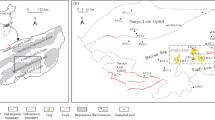Abstract
UNDERSTANDING the changes in porosity that occur during burial of sediments is of importance both in modelling fluid flow in sedimentary basins and for prediction of petroleum reservoir quality. When deposited, up to 50% of the volume of sands is intergranular pore space. Porosity generally decreases with depth because of compaction and precipitation of diagenetic minerals, but some sandstones retain an anomalously high porosity. Whether this is due to dissolution and removal of material or to its local redistribution is not clear. We originally intended to quantify losses of major chemical components during burial of a complete sedimentary unit. We have investigated ten reservoir sandstones, of Permian to Tertiary age, from oilfields worldwide. These show consistent results, and here we present detailed data from four of them. We found that the silica content of these sandstones actually increased, by 220 to 350 kg m−3, following compaction. No statistically significant changes were observed for aluminium, potassium or sodium. The flux of silica cannot be modelled satisfactorily using currently accepted values of permeability, silica solubility and flow rates, posing a challenge for existing models of fluid flow and ore emplacement.
This is a preview of subscription content, access via your institution
Access options
Subscribe to this journal
Receive 51 print issues and online access
$199.00 per year
only $3.90 per issue
Buy this article
- Purchase on Springer Link
- Instant access to full article PDF
Prices may be subject to local taxes which are calculated during checkout
Similar content being viewed by others
References
Baldwin, B. & Butler, C. O. Bull. Am. Assoc. Petrol. Geol. 69, 622–626 (1985).
Schmidt, V. & McDonald, D. A. S.E.P.M. Spec. Publ. 26, 157–207 (1979).
Bjørlykke, K. in Sediment Diagenesis (eds Parker, A. & Sellwood, B. W.) 169–213 (Reidel, Dordrecht, 1983).
Bjø rlykke, K., Aagaard, P., Dypvik, H., Hastings, D. S. & Harper, A. S. in Habitat of Hydrocarbons on the Norwegian Continental Shelf (eds Spencer, A. M. et al.) 275–286 (Graham & Trotman, London, 1986).
However, J., Eslinger, E., Hower, M. E. & Perry, E. A. Bull. geol. Soc. 87, 725–737 (1976).
Foscolos, A. E. & Powell, T. G. in Facts and Principles of World Petroleum Occurrence, Memoir 6 (ed. Miall, A. D.) 153–172 (Canadian Society of Petroleum Geologists, Calgary, 1980).
Loucks, R. G., Dodge, M. M. & Galloway, W. E. Bureau Econ. Geol. Rep. Investigation No. 149. (University of Texas 1986).
Curtis, C. D., Petrowski, C. & Oertel, G. Nature 235, 98–100 (1972).
Coleman, M. L. & Raiswell, R. Geochim. cosmochim. Acta 45, 329–340 (1981).
Curtis, C. D., Coleman, M. L. & Love, L. G. Geochim. cosmochim. Acta 50, 2321–2334 (1986).
Lippmann, F. Geol. Rundsch. 43, 475–503 (1955).
Oertel, G. & Curtis, C. D. Geol. Soc. Am. Bull. 83, 2597–2606 (1972).
Raiswell, R. Sedimentology 17, 147–171 (1971).
Thompson, M. & Walsh, J. N. A Handbook of ICP Spectrometry (Blackie, Glasgow, 1983).
Curtis, B. F. in Procedures in Sedimentary Petrology (ed. Carver, R. E.) 335–364 (Wiley-Interscience, New York, 1971).
Garrels, R. M. & Mackenzie, F. T. Evolution of Sedimentary Rocks (Norton, New York, 1971).
Robinson, A. G. & Gluyas, J. G. Mar. Petrol. Geol. (in the press).
Pettijohn, E. J. Sedimentary Rocks, 3rd edn, 76–77 (Harper & Row, New York, 1975).
Raiswell, R. & White, N. J. M. Sedim. Geol. 20 (1978).
Pettijohn, E. J. Sedimentary Rocks, 3rd edn, 20–23 (Harper & Row, New York, 1975).
Irwin, H. & Hurst, A. in Petroleum Geochemistry & Exploration of Europe, Geol. Soc. Spec. Publ. 12 (ed. Brooks, J.) 127–146, 1983).
McLimans, R. K. Appl. Geochem. 2, 585–603 (1987).
Boles, J. R. in Clays and the Resource Geologist (ed. Longstaffe, F. J.) 148–168 (Mineralogical Society of Canada, 1981).
Dypvik, H. Am. Assoc. Petrol. Geol. Bull. 67, 160–165 (1983).
Evans, I. J. in Water Rock Interaction WRI-6 (ed. Miles, D.) 219–222 (Balkema, Rotterdam, 1989).
Bethke, C. M., Harrison, W. J., Upson, C. & Altaner, S. P. Science 239, 261–267 (1988).
Robinson, A. G. & Gluyas, J. G. in Abstr. 13th Int. Sedimentol. Congress 462 (International Association of Sedimentology. Utrecht, 1990).
Bennett, P. C. & Siegal, D. I. in Water Rock Interaction WRI-6 (ed. Miles, D.) 219–222 (Balkema, Rotterdam. 1989).
Author information
Authors and Affiliations
Rights and permissions
About this article
Cite this article
Gluyas, J., Coleman, M. Material flux and porosity changes during sediment diagenesis. Nature 356, 52–54 (1992). https://doi.org/10.1038/356052a0
Received:
Accepted:
Issue Date:
DOI: https://doi.org/10.1038/356052a0
This article is cited by
-
Impact of a Porosity-Dependent Retention Function on Simulations of Porous Flow
Transport in Porous Media (2019)
-
How important is carbonate dissolution in buried sandstones: evidences from petrography, porosity, experiments, and geochemical calculations
Petroleum Science (2019)
-
Selective dissolution of eodiagenesis cements and its impact on the quality evolution of reservoirs in the Xing’anling Group, Suderte Oil Field, Hailar Basin, China
Petroleum Science (2016)
Comments
By submitting a comment you agree to abide by our Terms and Community Guidelines. If you find something abusive or that does not comply with our terms or guidelines please flag it as inappropriate.



